Indicative Effect of Excess Topography on Potential Risk Location of Giant Ancient Landslides—A Case Study in Lengqu River Section
Abstract
1. Introduction
2. Study Area
3. Research Data and Methods
3.1. Research Data
3.2. Research Methodology
3.2.1. RRIM Terrain Visualization Map
3.2.2. Excess Topography
4. Results
4.1. Identification and Preliminary Validation of GALs in Lengqu River Section Based on RRIM
4.2. Quantitative Analysis of the Relationship between GALs and Excess Topography in Lengqu River Section
4.2.1. Quantitative Analysis of the Relationship between the Location of GALs and Excess Topography in Lengqu River Section
4.2.2. Quantitative Analysis of the Relationship between Resurgent GALs and Excess Topography in Lengqu River Section
5. Discussion
5.1. Characteristic Basis for RRIM to Identify GALs in Lengqu River Section
5.2. Indication of Excess Topography for the Re-Occurrence of New Landslides on GALs
5.3. Indication of Excess Topography for Secondary Resurgence of GALs
6. Conclusions
- (1)
- The RRIM method used in the Lengqu River section makes visible the morphology and color features of the landslide occurrence that are obviously different from the surrounding areas, which provides good technical support for the census of GALs.
- (2)
- A total of 77.75% of the GALs in the Lengqu River section are still on excess topography, which means that the vast majority of the GALs are still at risk of new landslides; 68.38% of the 5 resurgent GALs, which are almost unaffected by human activities in the Lengqu River section, are on excess topography, 62.21% of the inactive GAL depositions are on the non-excess topography, and these results all indicate that the excess topography has an indicative effect on GAL resurrection in the natural state to a certain extent.
- (3)
- In the future, the RRIM method can be used to interpret smaller landslides with a higher-resolution DEM. At the same time, we can try to conduct quantitative analysis on the relationship between landslides in different regions, resurgent landslides and excess topography for further assessment of landslide risk with the help of the concept of excess topography. However, the decoding laws for smaller landslides based on the RRIM need to be recapitulated, and how to select the appropriate threshold hillslope for a new study area is also important.
Author Contributions
Funding
Institutional Review Board Statement
Informed Consent Statement
Data Availability Statement
Conflicts of Interest
References
- Petley, D. Global patterns of loss of life from landslides. Geology 2012, 40, 927–930. [Google Scholar] [CrossRef]
- Singh, P.; Maurya, V.; Dwivedi, R. Pixel based landslide identification using Landsat 8 and GEE. In Proceedings of the IEEE International Geoscience and Remote Sensing Symposium IGARSS, Brussels, Belgium, 11–16 July 2021; Volume XLIII-B3, pp. 721–726. [Google Scholar]
- Mondini, A.C.; Guzzetti, F.; Reichenbach, P.; Rossi, M.; Cardinali, M.; Ardizzone, F. Semi-automatic recognition and mapping of rainfall induced shallow landslides using optical satellite images. Remote Sens. Environ. 2011, 115, 1743–1757. [Google Scholar] [CrossRef]
- Cheng, K.S.; Wei, C.; Chang, S.C. Locating landslides using multi-temporal satellite images. Adv. Space Res. 2004, 33, 296–301. [Google Scholar] [CrossRef]
- Lindsay, E.; Frauenfelder, R.; Ruther, D.; Nava, L.; Rubensdotter, L.; Strout, J.; Nordal, S. Multi-Temporal Satellite Image Composites in Google Earth Engine for Improved Landslide Visibility: A Case Study of a Glacial Landscape. Remote Sens. 2022, 14, 2301. [Google Scholar] [CrossRef]
- Handwerger, A.L.; Huang, M.H.; Jones, S.Y.; Amatya, P.; Kerner, H.R.; Kirschbaum, D.B. Generating landslide density heatmaps for rapid detection using open-access satellite radar data in Google Earth Engine. Nat. Hazards Earth Syst. Sci. 2022, 22, 753–773. [Google Scholar] [CrossRef]
- Sreelakshmi, S.; Vinod Chandra, S.S.; Shaji, E. Landslide identification using machine learning techniques: Review, motivation, and future prospects. Earth Sci. Inform. 2022, 15, 2063–2090. [Google Scholar]
- Ghorbanzadeh, O.; Blaschke, T.; Gholamnia, K.; Meena, S.R.; Tiede, D.; Aryal, J. Evaluation of Different Machine Learning Methods and Deep-Learning Convolutional Neural Networks for Landslide Detection. Remote Sens. 2019, 11, 196. [Google Scholar] [CrossRef]
- Shi, W.Z.; Zhang, M.; Ke, H.F.; Fang, X.; Zhan, Z.; Chen, S.X. Landslide Recognition by Deep Convolutional Neural Network and Change Detection. IEEE Trans. Geosci. Remote Sens. 2021, 59, 4654–4672. [Google Scholar] [CrossRef]
- Xie, M.L.; Zhao, W.H.; Ju, N.P.; He, C.Y.; Huang, H.D.; Cui, Q.H. Landslide evolution assessment based on InSAR and real-time monitoring of a large reactivated landslide, Wenchuan, China. Eng. Geol. 2020, 277, 105781. [Google Scholar] [CrossRef]
- Xie, M.W.; Huang, J.X.; Wang, L.W.; Huang, J.H.; Wang, Z.F. Early landslide detection based on D-InSAR technique at the Wudongde hydropower reservoir. Environ. Earth Sci. 2016, 75, 717. [Google Scholar] [CrossRef]
- Rosi, A.; Tofani, V.; Tanteri, L.; Stefanelli, C.T.; Agostini, A.; Catani, F.; Casagli, N. The new landslide inventory of Tuscany (Italy) updated with PS-InSAR: Geomorphological features and landslide distribution. Landslides 2018, 15, 5–19. [Google Scholar] [CrossRef]
- Su, X.J.; Zhang, Y.; Meng, X.M.; Yue, D.X.; Ma, J.H.; Guo, F.Y.; Zhou, Z.Q.; Rehman, M.U.; Khalid, Z.; Chen, G.; et al. Landslide mapping and analysis along the China-Pakistan Karakoram Highway based on SBAS-InSAR detection in 2017. J. Mt. Sci. 2021, 18, 2540–2564. [Google Scholar] [CrossRef]
- Zhou, C.; Cao, Y.; Hu, X.; Yin, K.L.; Wang, Y.; Catani, F. Enhanced dynamic landslide hazard mapping using MT-InSAR method in the Three Gorges Reservoir Area. Landslides 2022, 19, 1585–1597. [Google Scholar] [CrossRef]
- Mishra, V.; Jain, K. Satellite based assessment of artificial reservoir induced landslides in data scarce environment: A case study of Baglihar reservoir in India. J. Appl. Geophys. 2022, 205, 104754. [Google Scholar] [CrossRef]
- Ke, H.F. Research on DEM-Aided Landslide Extraction Method from Aerial Images. Master’s Thesis, Wuhan University, Wuhan, China, 2020. (In Chinese with English Abstract). [Google Scholar]
- Rui, J.; Jin, F.; Xie, H.; Wang, C.; Zhang, H. Landslide detection based on DEM matching. J. Geomat. Sci. Technol. 2018, 35, 477484, (In Chinese with English Abstract). [Google Scholar]
- Yokoyama, R.; Pike, R.J. Visualizing topography by openness: A new application of image processing to digital elevation models. Photogramm. Eng. Remote Sens. 2002, 68, 257–266. [Google Scholar]
- Chiba, T.; Kaneta, S.; Suzuki, Y. Red relief image map: New visualization method for three dimensional data. In Proceedings of the 21st International Society for Photogrammetry and Remote Sensing (ISPRS 2008), Beijing, China, 3 July 2008; pp. 2274–2279. [Google Scholar]
- Chiba, T.; Hasi, B. Ground surface visualization using red relief image map for a variety of map scales. Int. Arch. Photogramm. Remote Sens. Spat. Inf. Sci. 2016, XLI-B2, 393–397. [Google Scholar] [CrossRef]
- Gorum, T. Landslide recognition and mapping in a mixed forest environment from airborne LiDAR data. Eng. Geol. 2019, 258, 105155. [Google Scholar] [CrossRef]
- Zingaro, M.; Salandra, M.L.; Colacicco, R.; Roseto, R.; Petio, P.; Capolongo, D. Suitability assessment of global, continental and national digital elevation models for geomorphological analyses in Italy. Trans. GIS 2021, 25, 2283–2308. [Google Scholar] [CrossRef]
- Salandra, M.L.; Roseto, R.; Mele, D.; Dellino, P.; Capolongo, D. Probabilistic hydro-geomorphological hazard assessment based on UAV-derived high-resolution topographic data: The case of Basento river (Southern Italy). Sci. Total Environ. 2022, 842, 156736. [Google Scholar] [CrossRef]
- Luo, X.K. Study on the Relationship between Giant Ancient Landslides and River Terraces in the Middle Part of the Upper Minjiang River. Master’s Thesis, China University of Geosciences, Beijing, China, 2019. (In Chinese with English Abstract). [Google Scholar]
- Ma, Y.L.; Wu, H.; Zhang, W.H. Exploring the application of remote sensing technology in landslide identification. Technol. Innov. Appl. 2022, 12, 142–145, (In Chinese with English Abstract). [Google Scholar]
- Azarafza, M.; Azarafza, M.; Akgun, H.; Atkinson, P.M.; Derakhshani, R. Deep learning-based landslide susceptibility mapping. Sci. Rep. 2021, 11, 24112. [Google Scholar] [CrossRef]
- Nanehkaran, Y.A.; Licai, Z.; Chen, J.; Azarafza, M.; Yimin, M. Application of artificial neural networks and geographic information system to provide hazard susceptibility maps for rockfall failures. Environ. Earth Sci. 2022, 81, 475. [Google Scholar] [CrossRef]
- Nanehkaran, Y.A.; Mao, Y.M.; Azarafza, M.; Kockar, M.K.; Zhu, H.H. Fuzzy-based multiple decision method for landslide susceptibility and hazard assessment: A case study of Tabriz, Iran. Geomech. Eng. 2021, 24, 407–418. [Google Scholar]
- Nikoobakht, S.; Azarafza, M.; Akgun, H.; Derakhshani, R. Landslide Susceptibility Assessment by Using Convolutional Neural Network. Appl. Sci. 2022, 12, 5992. [Google Scholar] [CrossRef]
- Blothe, J.H.; Korup, O.; Schwanghart, W. Large landslides lie low: Excess topography in the Himalaya-Karakoram ranges. Geology 2015, 43, 523–526. [Google Scholar] [CrossRef]
- Liu, W.M.; Zhou, Z.; Zhou, L.Q.; Chen, X.Q.; Yanites, B.; Zhou, Y.L.; Li, X.M.; Zhang, X.G. Analysis of Hillslope Erosion Based on Excess Topography in Southeastern Tibet. Front. Earth Sci. 2021, 9, 684365. [Google Scholar] [CrossRef]
- Zhang, Y.S.; Hu, D.G.; Wu, Z.H.; Zhang, J.G. Study on Crustal Stability and Major Engineering Geological Problems along Yunnan Tibet Railway; Geological Publishing House: Beijing, China, 2009; (In Chinese with English Abstract). [Google Scholar]
- Yao, X.; Deng, J.H.; Liu, X.H.; Zhou, Z.K.; Yao, J.M.; Dai, F.C.; Ren, K.Y.; Li, L.J. InSAR preliminary identification and development law analysis of active landslides in the pan-three-river confluence area of the Qinghai-Tibet Plateau. Adv. Eng. Sci. 2020, 52, 16–37, (In Chinese with English Abstract). [Google Scholar]
- Wang, X.; Fan, X.M.; Yang, F.; Dong, X.J. Study on remote sensing interpretation of geological hazards in mountainous areas with dense vegetation. Geomat. Inf. Sci. Wuhan Univ. 2020, 45, 1771–1781, (In Chinese with English Abstract). [Google Scholar]
- Zhou, Z. Analysis of Slope Erosion in Hengduan Mountain Area Based on Critical Slope. Master’s Thesis, Southwest Jiaotong University, Chengdu, China, 2020. (In Chinese with English Abstract). [Google Scholar]
- Schwanghart, W.; Kuhn, N.J. TopoToolbox: A set of Matlab functions for topographic analysis. Environ. Model. Softw. 2010, 25, 770–781. [Google Scholar] [CrossRef]
- Dong, X.J.; Yin, T.; Dai, K.R.; Pirasteh, S.; Zhuo, G.C.; Li, Z.Y.; Yu, B.; Xu, Q. Identifying Potential Landslides on Giant Niexia Slope (China) Based on Integrated Multi-Remote Sensing Technologies. Remote Sens. 2022, 14, 6328. [Google Scholar] [CrossRef]
- Süzen, M.L.; Doyuran, V. Data driven bivariate landslide susceptibility assessment using geographical information systems: A method and application to Asarsuyu catchment, Turkey. Eng. Geol. 2004, 71, 303–321. [Google Scholar] [CrossRef]
- Bai, S.B. Study on Landslide Hazard Assessment Model Supported by GIS—A Case Study of Zhongxian-Shizhu Reach in the Three Gorges Reservoir Area. Ph.D. Thesis, Aanjing Normal University, Nanjing, China, 2005. (In Chinese with English Abstract). [Google Scholar]
- Liu, H.C.; Li, L.; Wu, B.X.; Yao, H.Q. The mode, mechanism and condition of landslide reactivation in a certain area. Geol. Hazards Environ. Preserv. 1990, 1, 37–45, (In Chinese with English Abstract). [Google Scholar]
- Zhang, Y.S.; Wu, R.A.; Guo, C.B.; Wang, L.C.; Yao, X.; Yang, Z.H. Research progress and prospect of ancient landslide reactivation. Adv. Earth Sci. 2018, 33, 728–740, (In Chinese with English Abstract). [Google Scholar]
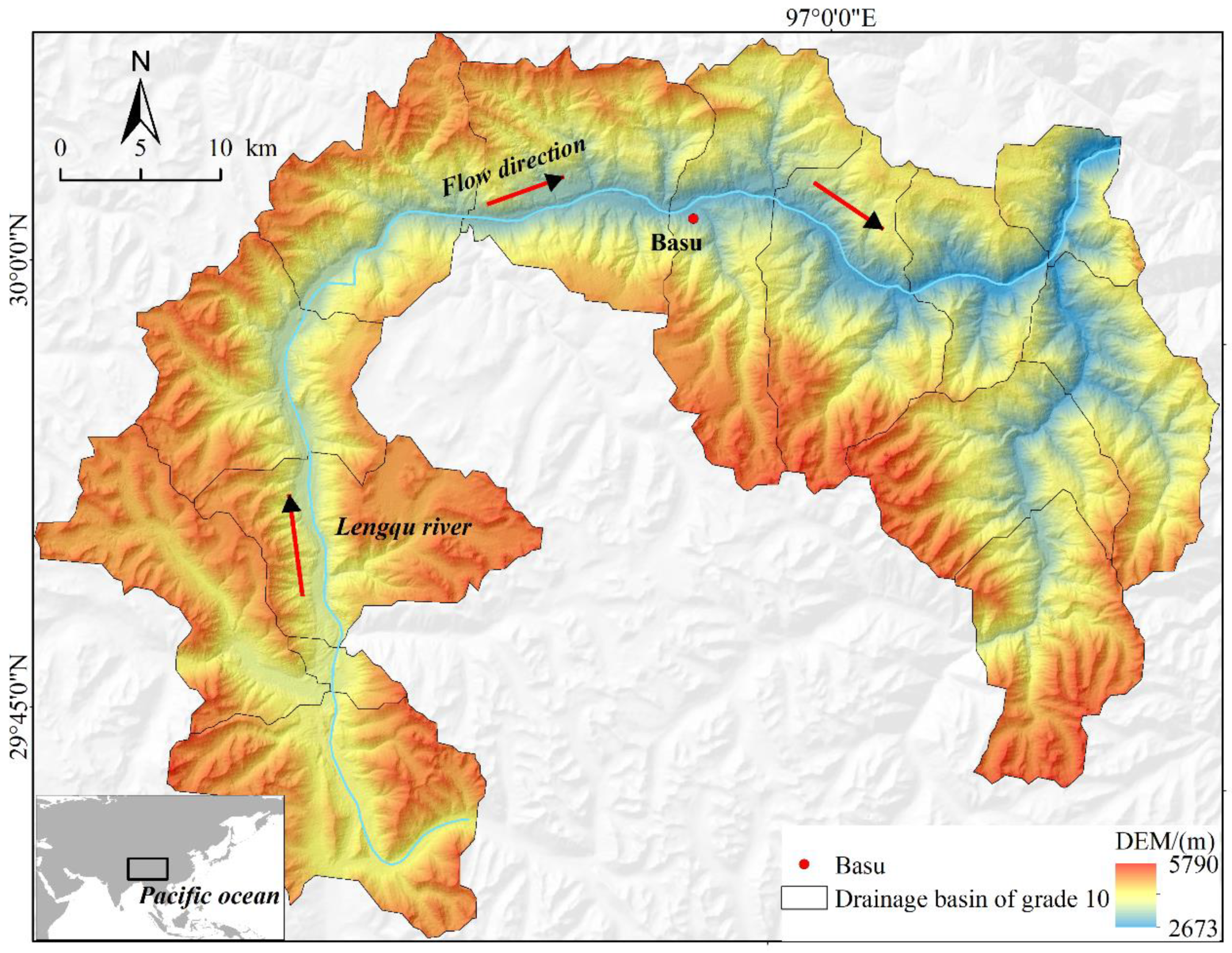
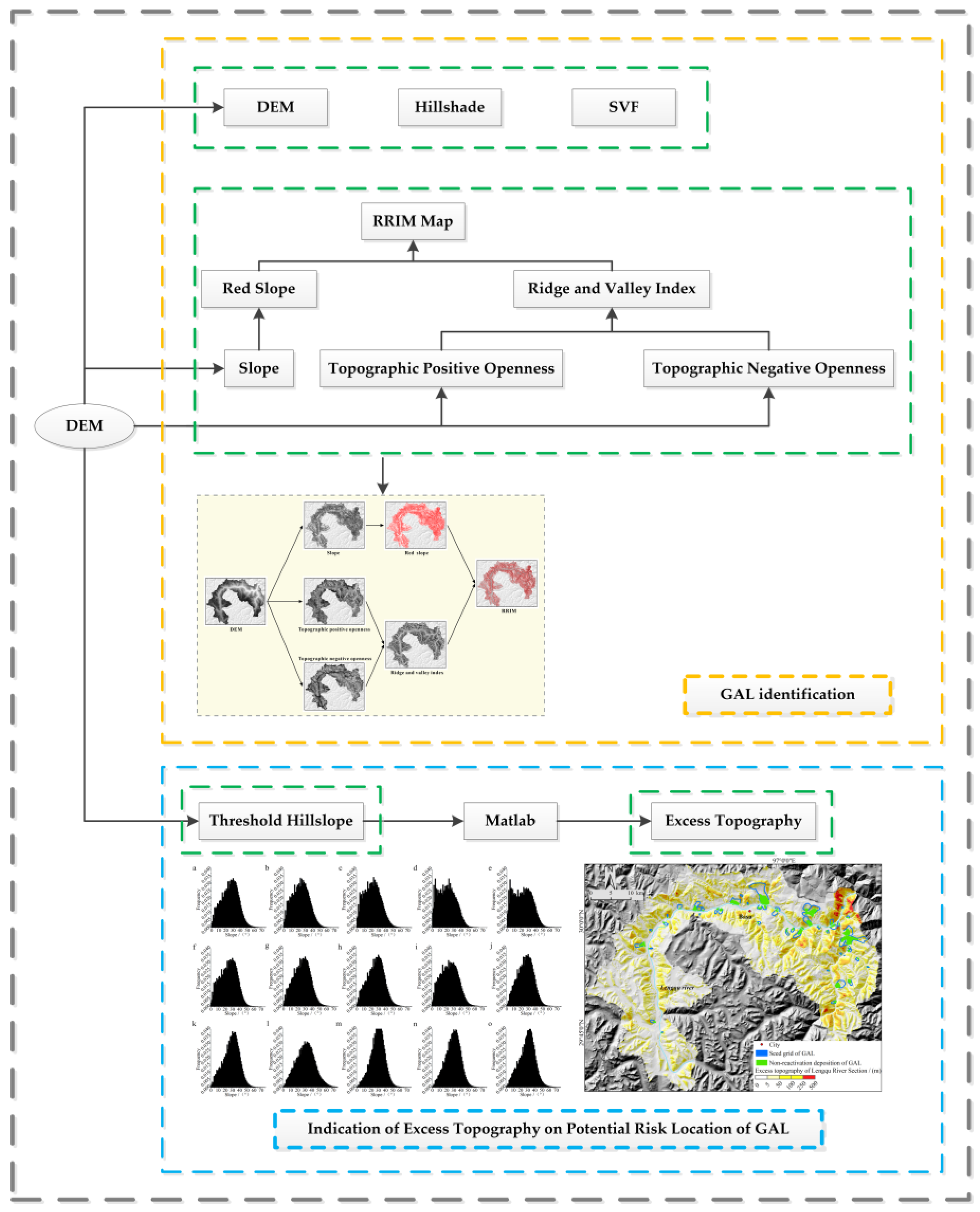
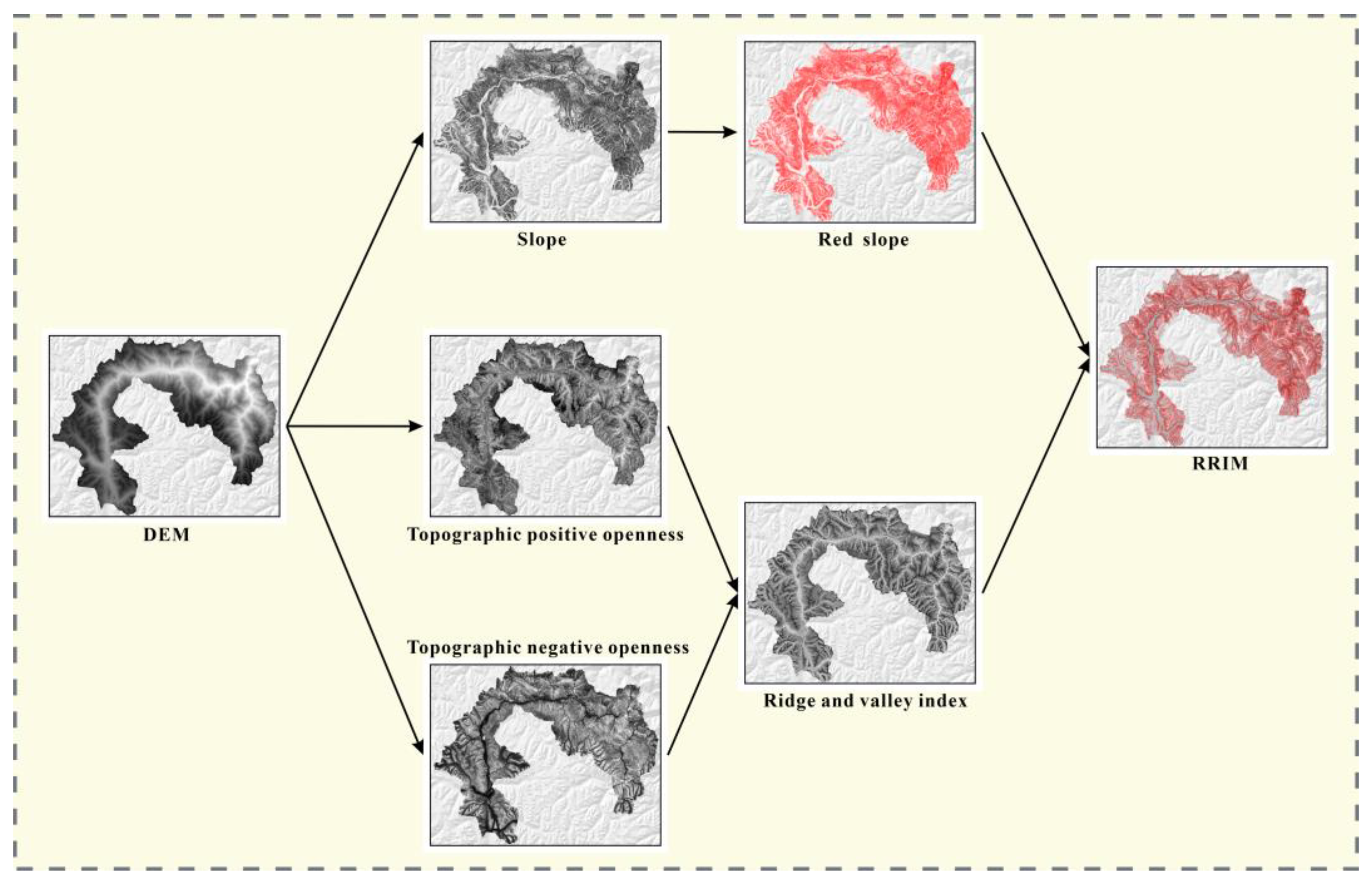
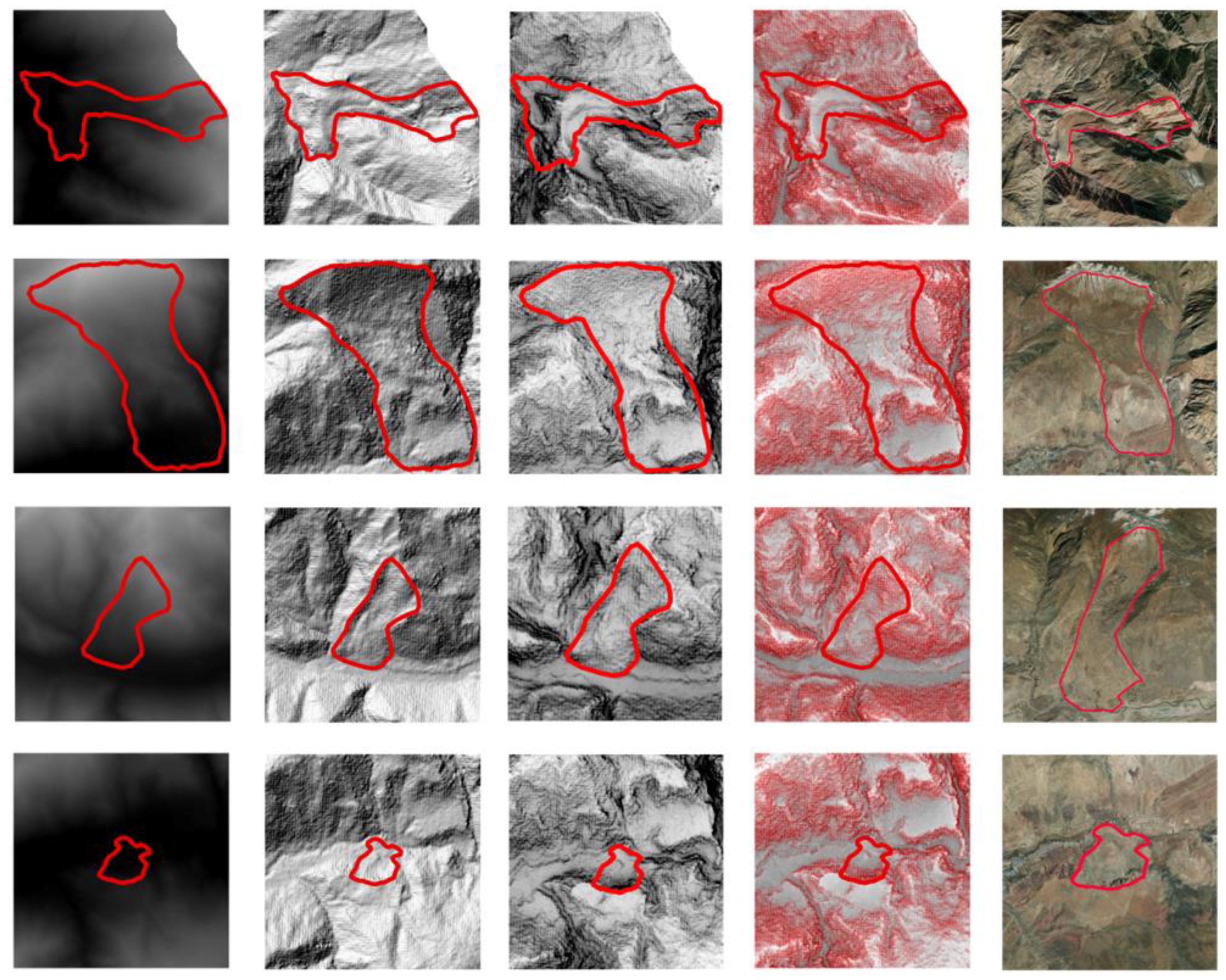
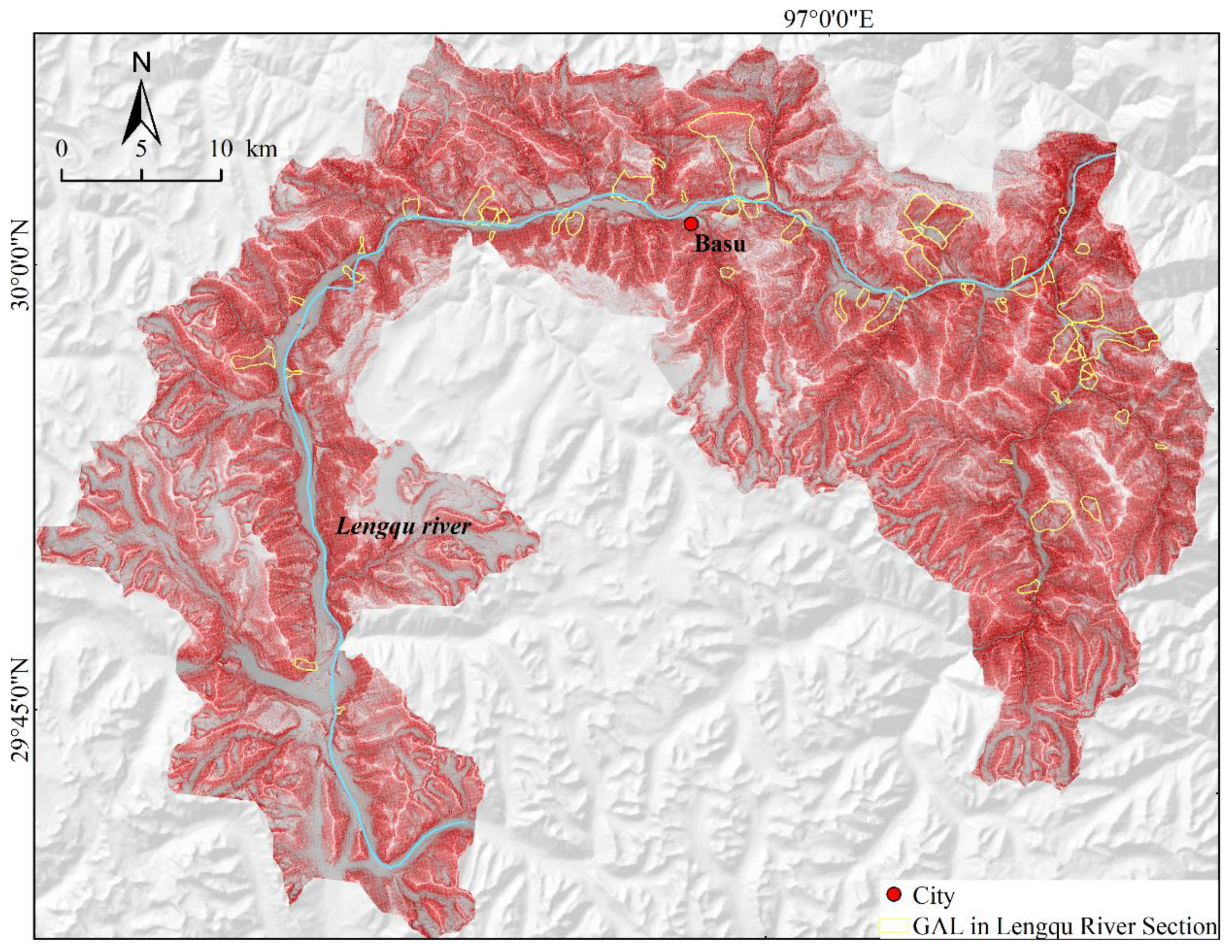


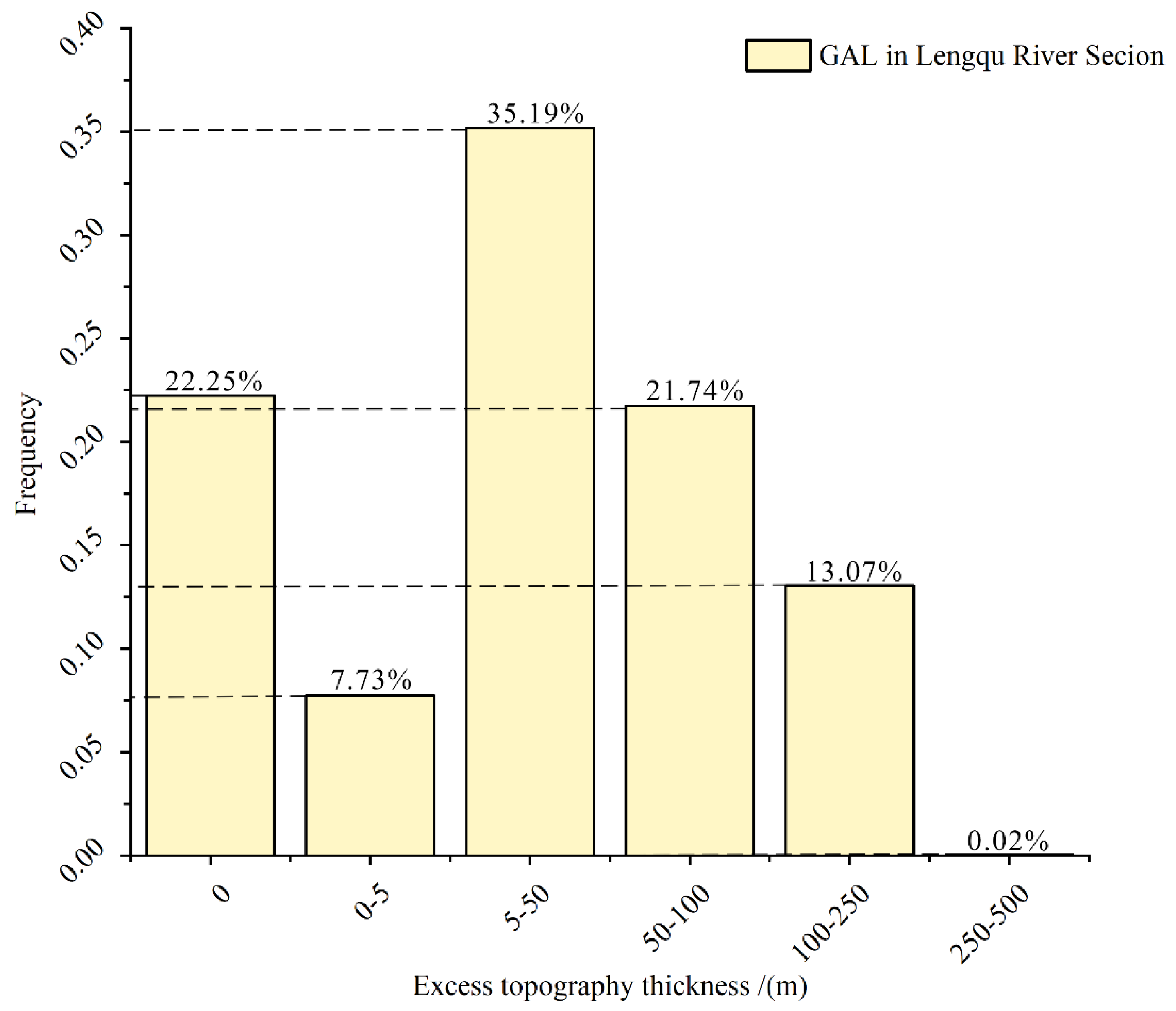

| Data | Source |
|---|---|
| 12.5 × 12.5 m DEM InSAR-based identification of resurgent GAL data in the upper reaches of Nujiang River Basin | https://search.asf.alaska.edu/ (1 January 2023) Yao X. et al. Preliminary identification and developmental pattern analysis of active landslides based on InSAR in the pan-Sanjiang parallel flow area of Qinghai–Tibet Plateau |
| Location | Slope |
|---|---|
| Mode slope in Lengqu River section | 30° |
| Mean slope in Lengqu River section | 26° |
| Sub-basin b | 23° |
| Sub-basin c | 23° |
| Sub-basin d | 23° |
| Sub-basin e | 4° |
| Sub-basin f | 30° |
| Sub-basin g | 30° |
| Sub-basin h | 30° |
| Sub-basin i | 30° |
| Sub-basin j | 23° |
| Sub-basin k | 30° |
| Sub-basin l | 30° |
| Sub-basin m | 30° |
| Sub-basin n | 30° |
| Sub-basin o | 34° |
Disclaimer/Publisher’s Note: The statements, opinions and data contained in all publications are solely those of the individual author(s) and contributor(s) and not of MDPI and/or the editor(s). MDPI and/or the editor(s) disclaim responsibility for any injury to people or property resulting from any ideas, methods, instructions or products referred to in the content. |
© 2023 by the authors. Licensee MDPI, Basel, Switzerland. This article is an open access article distributed under the terms and conditions of the Creative Commons Attribution (CC BY) license (https://creativecommons.org/licenses/by/4.0/).
Share and Cite
Wang, X.; Bai, S. Indicative Effect of Excess Topography on Potential Risk Location of Giant Ancient Landslides—A Case Study in Lengqu River Section. Appl. Sci. 2023, 13, 8085. https://doi.org/10.3390/app13148085
Wang X, Bai S. Indicative Effect of Excess Topography on Potential Risk Location of Giant Ancient Landslides—A Case Study in Lengqu River Section. Applied Sciences. 2023; 13(14):8085. https://doi.org/10.3390/app13148085
Chicago/Turabian StyleWang, Xin, and Shibiao Bai. 2023. "Indicative Effect of Excess Topography on Potential Risk Location of Giant Ancient Landslides—A Case Study in Lengqu River Section" Applied Sciences 13, no. 14: 8085. https://doi.org/10.3390/app13148085
APA StyleWang, X., & Bai, S. (2023). Indicative Effect of Excess Topography on Potential Risk Location of Giant Ancient Landslides—A Case Study in Lengqu River Section. Applied Sciences, 13(14), 8085. https://doi.org/10.3390/app13148085







